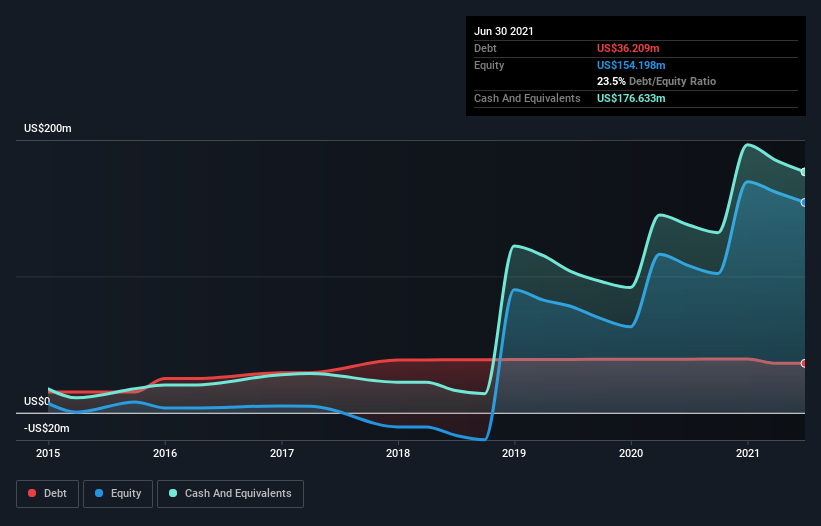
Some say volatility, rather than debt, is the best way to think about risk as an investor, but Warren Buffett famously said that 'Volatility is far from synonymous with risk.' It's only natural to consider a company's balance sheet when you examine how risky it is, since debt is often involved when a business collapses. We can see that SI-BONE, Inc. (NASDAQ:SIBN) does use debt in its business. But the real question is whether this debt is making the company risky.
When Is Debt Dangerous?
Debt is a tool to help businesses grow, but if a business is incapable of paying off its lenders, then it exists at their mercy. If things get really bad, the lenders can take control of the business. However, a more usual (but still expensive) situation is where a company must dilute shareholders at a cheap share price simply to get debt under control. Of course, the upside of debt is that it often represents cheap capital, especially when it replaces dilution in a company with the ability to reinvest at high rates of return. When we think about a company's use of debt, we first look at cash and debt together.
Check out our latest analysis for SI-BONE
How Much Debt Does SI-BONE Carry?
As you can see below, SI-BONE had US$36.2m of debt at June 2021, down from US$39.3m a year prior. However, it does have US$176.6m in cash offsetting this, leading to net cash of US$140.4m.

How Strong Is SI-BONE's Balance Sheet?
According to the last reported balance sheet, SI-BONE had liabilities of US$12.6m due within 12 months, and liabilities of US$40.5m due beyond 12 months. On the other hand, it had cash of US$176.6m and US$11.9m worth of receivables due within a year. So it can boast US$135.4m more liquid assets than total liabilities.
This surplus suggests that SI-BONE is using debt in a way that is appears to be both safe and conservative. Given it has easily adequate short term liquidity, we don't think it will have any issues with its lenders. Simply put, the fact that SI-BONE has more cash than debt is arguably a good indication that it can manage its debt safely. The balance sheet is clearly the area to focus on when you are analysing debt. But ultimately the future profitability of the business will decide if SI-BONE can strengthen its balance sheet over time. So if you want to see what the professionals think, you might find this free report on analyst profit forecasts to be interesting.
In the last year SI-BONE wasn't profitable at an EBIT level, but managed to grow its revenue by 27%, to US$85m. With any luck the company will be able to grow its way to profitability.
So How Risky Is SI-BONE?
By their very nature companies that are losing money are more risky than those with a long history of profitability. And in the last year SI-BONE had an earnings before interest and tax (EBIT) loss, truth be told. Indeed, in that time it burnt through US$36m of cash and made a loss of US$45m. While this does make the company a bit risky, it's important to remember it has net cash of US$140.4m. That means it could keep spending at its current rate for more than two years. With very solid revenue growth in the last year, SI-BONE may be on a path to profitability. Pre-profit companies are often risky, but they can also offer great rewards. When analysing debt levels, the balance sheet is the obvious place to start. But ultimately, every company can contain risks that exist outside of the balance sheet. For example - SI-BONE has 4 warning signs we think you should be aware of.
At the end of the day, it's often better to focus on companies that are free from net debt. You can access our special list of such companies (all with a track record of profit growth). It's free.
New: Manage All Your Stock Portfolios in One Place
We've created the ultimate portfolio companion for stock investors, and it's free.
• Connect an unlimited number of Portfolios and see your total in one currency
• Be alerted to new Warning Signs or Risks via email or mobile
• Track the Fair Value of your stocks
This article by Simply Wall St is general in nature. We provide commentary based on historical data and analyst forecasts only using an unbiased methodology and our articles are not intended to be financial advice. It does not constitute a recommendation to buy or sell any stock, and does not take account of your objectives, or your financial situation. We aim to bring you long-term focused analysis driven by fundamental data. Note that our analysis may not factor in the latest price-sensitive company announcements or qualitative material. Simply Wall St has no position in any stocks mentioned.
Have feedback on this article? Concerned about the content? Get in touch with us directly. Alternatively, email editorial-team (at) simplywallst.com.
About NasdaqGM:SIBN
SI-BONE
A medical device company, that operate to solve musculoskeletal disorders of the sacropelvic anatomy in the United States and internationally.
Flawless balance sheet and slightly overvalued.
Similar Companies
Market Insights
Community Narratives




